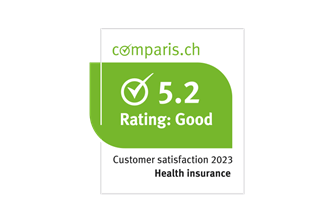
Cataracts and glaucoma: symptoms and treatment
Many people are familiar with the terms cataract and glaucoma. The health tip explains how these two eye diseases differ and why it's important to have regular check-ups.
Cataracts and glaucoma are eye diseases with significantly different symptoms and treatment. Cataracts are usually very treatable but the same cannot be said of glaucoma.
Cataracts
A cataract is a clouding of the lens of the eye. Those affected are mostly over 50 years of age (but cataracts can also occur in younger individuals). "Almost everyone experiences clouding of the eye lenses from the age of 65 at the latest," explains Dr Silke Schmitt Oggier, Medical Director of santé24. Although cataracts do not respond to medication, they can be treated surgically by removing the clouded lens and replacing it with an artificial lens. Besides the ageing process, the risk factors for cataracts are UV light, heavy smoking, prolonged use of cortisone-based medication, diabetes and family history.Symptoms of cataracts
The following symptoms typically occur with cataracts:- reduced visual acuity
- colours appear pale
- spatial perception is impaired
- "veil vision" (like having a veil in front of the eyes)
- increased glare sensitivity (when driving at night, for example)
- difficulty seeing in the dark
Almost everyone experiences clouding of the eye lenses from the age of 65 at the latest. Dr Silke Schmitt Oggier, Medical Director at santé24
Glaucoma
In the worst case, glaucoma can lead to blindness if the disease is not diagnosed and treated in time. Glaucoma is caused by increased pressure inside the eye, improper vascular regulation and too low or too high blood pressure. Known risk factors are age, severe short- or long-sightedness above four dioptres, a family history of glaucoma, and smoking. Glaucoma is diagnosed by examining fluid pressure in the eye, the visual field and the optic nerve.Glaucoma treatment
Many people with glaucoma need to have the pressure in their eye(s) reduced, using medication and/or surgery. This can often prevent or at least slow down the progression of the illness. Glaucoma is an insidious disease and often goes unnoticed because there are no accompanying symptoms such as pain. In most cases, the eyesight, once lost, cannot be restored. "For this reason, and precisely because the risk of glaucoma increases massively with age, preventive check-up should be carried out by an ophthalmologist every five years from the age of 50, or earlier and more frequently if there are risk factors," recommends Dr Silke Schmitt Oggier.SWICA BENECURA
For some time now, colours have appeared pale to you, and you seem to have a kind of veil in front of your eyes. You don't know whether you should go to your family doctor, a pharmacy, or even a hospital? No problem. The BENECURA app from SWICA is there to help when you feel unwell or become ill. SWICA customers can use the SymptomCheck feature of the BENECURA app, which was developed by doctors, to obtain information easily, quickly and reliably and immediately receive a personal recommendation about what to do next.24.03.2021
In the event of further health-related questions, SWICA customers can contact the santé24 telemedicine service free of charge on +41 44 404 86 86. A telemedicine practice licence allows santé24 physicians to provide additional medical services in cases that are suited to a telemedicine approach. SWICA customers can also use the BENECURA medical app to carry out a digital SymptomCheck and receive recommendations about what to do next. During a subsequent phone call with santé24, customers can decide for themselves whether to release their information from SymptomCheck to santé24.




